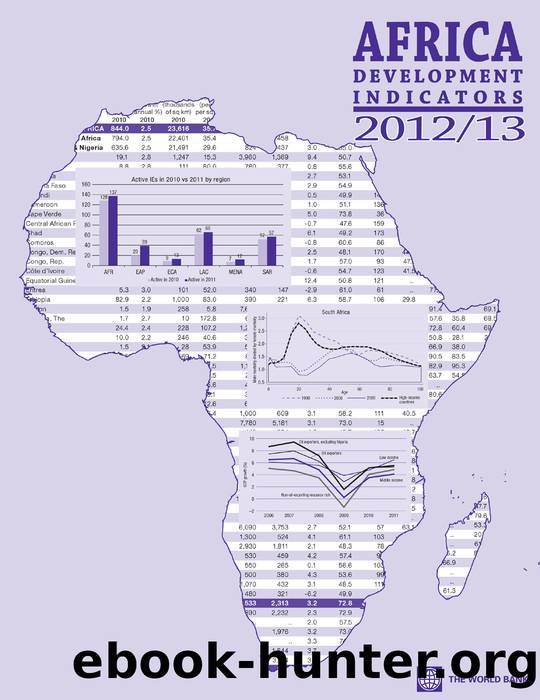Africa Development Indicators 20122013 by Unknown

Author:Unknown
Language: eng
Format: epub
Publisher: The World Bank
Gender
Prepared by Markus Goldstein
The 2012 World Development Report documents four central challenges to gender equality in Africa: reducing excess female mortality, closing gaps in earnings and productivity, shrinking differences in voice in households and society, and investing in youth to break intergenerational cycles of gender inequality. While the following box discusses the issue of mortality, here we explore the other three dimensions.
Gaps in earnings and productivity
Although many more women have joined the labor force throughout the developing world in the past 25 years, access to employment has led to neither equitable opportunities nor equitable earnings between women and men. There is considerable gender segregation in accessing labor force opportunitiesâwomen are more likely to work in low-productivity sectors, less-profitable areas, wage or unpaid family employment, or the informal wage sector. In agriculture, women have less access to inputs and manage smaller plots of land, particularly in Sub-Saharan Africa.
There are three main factors that lead to gender segregation among female farmers, entrepreneurs, and wage workers: (1) gender differences in time use (primarily resulting from differences in care responsibilities); (2) gender differences in access to productive inputs (particularly land and credit); and (3) gender differences stemming from market and institutional failures.
Employment: In Sub-Saharan Africa, firms managed by women have labor productivity 6 to 8 percent lower than firms managed by men. This number prevails when compared with Europe and Central Asia, where it is 34 percent lower, and in Latin America, where value added per worker is 35 percent lower in firms managed by women. The performance lag of female-owned firms is related to market segregation, where women are often constrained to less-productive sectors. For example, industry type accounts for 9 to 14 percent of the gender differential in earnings for self-employed workers. For formal firms in urban areas of Sub-Saharan Africa, this difference in operational sector accounts for more than 20 percent of the gap, while the size of the firm accounts for another 30 percent. Women are also overrepresented among unpaid and wage workers and in the informal sector. The region has the highest rate of unpaid female family workers, at 65 percent of total employed women. Eliminating barriers that prevent women from working in certain occupations or sectors would reduce the productivity gap between male and female workers by one-third to one-half and increase output per worker by 3 to 25 percent across a range of Sub-Saharan Africa countries.
Agricultural productivity: Though 44 percent of Sub-Saharan Africaâs agricultural labor force is comprised of women, female farmers in the region are less productive than male farmers, likely due to limited access to inputs including fertilizer, seed variety, as well as substantial plots of land, credit, and extension services. Productivity on farms would increase between 10 and 30 percent if women were provided with equal access to inputs. If women were granted equal access to inputs and more secure access to land, gender gaps in agricultural production would disappear and yields on womenâs farms would increase by 14 percent in Malawi, 17 percent in Ghana, 20 percent in Kenya, and 21 percent in Benin.
Download
This site does not store any files on its server. We only index and link to content provided by other sites. Please contact the content providers to delete copyright contents if any and email us, we'll remove relevant links or contents immediately.
Periodization Training for Sports by Tudor Bompa(8102)
The Body: A Guide for Occupants by Bill Bryson(4893)
The MacArthur Bible Commentary by John MacArthur(4688)
The Sports Rules Book by Human Kinetics(4221)
What It Really Takes to Get Into Ivy League and Other Highly Selective Colleges by Hughes Chuck(3649)
Marijuana Grower's Handbook by Ed Rosenthal(3591)
The Sprouting Book by Ann Wigmore(3516)
The Martian by Andy Weir(3255)
Salt, Fat, Acid, Heat: Mastering the Elements of Good Cooking by Nosrat Samin(3083)
The Bread Bible by Rose Levy Beranbaum(2975)
Sapiens and Homo Deus by Yuval Noah Harari(2949)
Harry Potter 4 - Harry Potter and The Goblet of Fire by J.K.Rowling(2949)
Classic by Mary Berry(2921)
The Marketing Plan Handbook: Develop Big-Picture Marketing Plans for Pennies on the Dollar by Robert W. Bly(2908)
Martha Stewart's Baking Handbook by Martha Stewart(2754)
The Plant Paradox by Dr. Steven R. Gundry M.D(2518)
Screenplay: The Foundations of Screenwriting by Syd Field(2512)
50 Economics Classics by Tom Butler-Bowdon(2489)
The Cambridge Grammar Of The English Language by Rodney Huddleston Geoffrey K. Pullum(2360)
